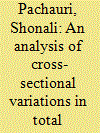|
|
|
Sort Order |
|
|
|
Items / Page
|
|
|
|
|
|
|
| Srl | Item |
| 1 |
ID:
052298


|
|
|
|
|
| Publication |
Oct 2004.
|
| Summary/Abstract |
Using micro level household survey data from India, we analyse the variation in the pattern and quantum of household energy requirements, both direct and indirect, and the factors causing such variation. An econometric analysis using household survey data from India for the year 1993–1994 reveals that household socio-economic, demographic, geographic, family and dwelling attributes influence the total household energy requirements. There are also large variations in the pattern of energy requirements across households belonging to different expenditure classes. Results from the econometric estimation show that total household expenditure or income level is the most important explanatory variable causing variation in energy requirements across households. In addition, the size of the household dwelling and the age of the head of the household are related to higher household energy requirements. In contrast, the number of members in the household and literacy of the head are associated with lower household energy requirements.
|
|
|
|
|
|
|
|
|
|
|
|
|
|
|
|
| 2 |
ID:
172301


|
|
|
|
|
| Summary/Abstract |
Ranking alongside the top bicycling nations of the world, Japan today boasts of a deeply engrained cycling culture. While the technological prowess of Japan’s bicycle industry is well known, there exists no scholarly study investigating the socio-cultural impact of cycling in Japan, specifically its role in emancipation of women. How the modern women of Japan scaled barriers to mobility riding their way to modernity in an oppressive male-dominated society is not yet known. The objective of this paper is to examine women cyclists in Japan in the context of modernisation. On the one hand, viewing bicycles helps examine the Japanese economy from the perspective of ordinary women as active consumers (as against their passive image) whose demand for bicycles was certainly an essential ingredient for the growth of bicycle industry. On the other hand, it serves to question the predominant view of consumption stagnation in interwar Japan. Most importantly, as countries around the world continue to make laudable efforts to encourage women cyclists, a leaf can be drawn by policymakers from the history of forgotten cycling heroines of Japan to accelerate women’s socio-economic empowerment.
|
|
|
|
|
|
|
|
|
|
|
|
|
|
|
|
| 3 |
ID:
140097


|
|
|
|
|
| Summary/Abstract |
This article provides a comprehensive overview of the global meat sector and examines significant food processing sub-sectors that are a major contributor to the global economy. Structural changes in global meat production, consumption and trade are analysed using recent Food and Agriculture Organisation statistical databases, in terms of geographic concentration or relocation of production or markets and temporal changes across major geographical regions. The findings indicate significant recent shifts in production, consumption and trade of different kinds of meat. While developing markets still focus on red meat, the developed markets are moving faster towards white meat due to increasing health and environmental concerns among consumers in recent years. The implications of such trends for South Asia are examined, too, and call for further research.
|
|
|
|
|
|
|
|
|
|
|
|
|
|
|
|
| 4 |
ID:
112326


|
|
|
|
|
| Publication |
2012.
|
| Summary/Abstract |
This paper examines the social factors that underlie the composition of final demand and, therefore, determine the final volume of emissions. The study throws light on the relationships between the parameters characterising Spanish households (income, urban/rural residence, local population density, head of household's level of education and social class) and their behaviour with regard to consumption and the demand for goods and services. On this basis, we determine which consumption patterns are best aligned with sustainable growth and development. Our main conclusion is that the factors analysed determine the volume of emissions for each household in terms of their correlation with income, which is the primary determinant of consumption patterns. The methodology proposed combines linear SAM models and econometric estimation of emissions elasticity with respect to spending.
|
|
|
|
|
|
|
|
|
|
|
|
|
|
|
|
|
|
|
|
|